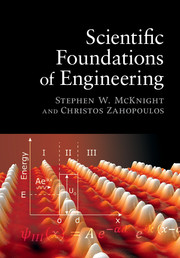Book contents
- Frontmatter
- Contents
- Introduction
- 1 Kinematics and vectors
- 2 Newton's Laws, energy, and momentum
- 3 Rotational motion
- 4 Rotation matrices
- 5 Materials properties: elasticity
- 6 Harmonic oscillation
- 7 Waves
- 8 The quantum puzzle
- 9 Quantum mechanics
- 10 Quantum electrons in atoms, molecules, and materials
- 11 Quantum electrons in solids
- 12 Thermal physics: energy, heat, and thermodynamics
- 13 Quantum statistics
- 14 Maxwell's equations and electromagnetism
- 15 Electromagnetic waves
- 16 Electromagnetic materials
- 17 Fluids
- Bibliography
- Index
8 - The quantum puzzle
Published online by Cambridge University Press: 05 September 2015
- Frontmatter
- Contents
- Introduction
- 1 Kinematics and vectors
- 2 Newton's Laws, energy, and momentum
- 3 Rotational motion
- 4 Rotation matrices
- 5 Materials properties: elasticity
- 6 Harmonic oscillation
- 7 Waves
- 8 The quantum puzzle
- 9 Quantum mechanics
- 10 Quantum electrons in atoms, molecules, and materials
- 11 Quantum electrons in solids
- 12 Thermal physics: energy, heat, and thermodynamics
- 13 Quantum statistics
- 14 Maxwell's equations and electromagnetism
- 15 Electromagnetic waves
- 16 Electromagnetic materials
- 17 Fluids
- Bibliography
- Index
Summary
By the end of the nineteenth century all the important elements of classical physics were fully mature. Newton's Laws had been applied with success to everything from industrial machines to planetary orbits. Classical thermodynamics had extended energy conservation arguments into thermal processes, and scientists including J. Willard Gibbs and Ludwig Boltzmann had developed the statistical interpretation of entropy. James Clerk Maxwell had explained all electromagnetic phenomena, from AC generators/motors to light, with the four Maxwell's equations and three material-dependent constitutive relations. There was serious discussion that physics was on the verge of being “finished” – becoming a closed system of knowledge like classical geometry with only essentially routine tasks left of determining how the known laws could be applied to engineering problems.
Yet by 1930 the foundations of mechanics, electromagnetics, and atomic-scale systems had been shaken to the core by the new revolutions in the Theory of Relativity, the photon picture of light, and quantum physics. We are still reaping the benefits of the application of these new scientific paradigms in our technology today, including semiconductor electronic devices, lasers, and GPS systems. But the description of reality that these theories provide is still deeply anti-intuitive and disturbing.
Nevertheless, quantum physics is one of the most extensively experimentally verified theories that we know. Even when quantum theory and common sense seem to diverge, quantum theory gives the right answers when tested by experiment. In the next chapter we will develop the framework of quantum theory that has been so successful when people “shut up and calculate,” as one scientist suggested as the way through the philosophical thicket of quantum physics. But in this chapter, we will spend a brief time considering the historical development and continuing paradoxical implications of quantum theory.
The photoelectric effect and photons
In 1905, Albert Einstein, who was a key figure in the revolution of modern physics, was working as a clerk in the patent office in Zurich, Switzerland. Einstein had finished his studies in physics, but had not obtained a coveted position as a university professor. He was intensely interested in the latest developments in classical physics and was aware of a few of the remaining loose ends that were resisting explanation in the classical model.
- Type
- Chapter
- Information
- Scientific Foundations of Engineering , pp. 131 - 147Publisher: Cambridge University PressPrint publication year: 2015



